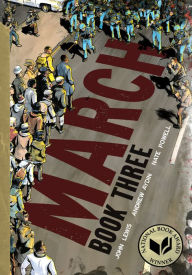From the Publisher
BOOKLIST (STARRED) —
A stirring call to action that's particularly timely in this election year, and one that will resonate and empower young readers in particular. Essential reading.
March is one of the most important graphic novels ever created - an extraordinary presentation of an extraordinary life,
and proof that young people can change the world. I'm stunned by the power of these comics, and grateful that Congressman Lewis's story will enlighten and inspire future generations of readers and leaders. - Raina
Telgemeier
KIRKUS (STARRED) — A living icon of the civil rights movement brings his frank and stirring account of the movement's most tumultuous years (so far) to a climax.
As chairman of the Student Non-Violent
Coordinating Committee between 1963 and 1966, Lewis was directly involved in both public demonstrations and behind-the-scenes meetings with government officials and African-American leaders. He recalls both with unflinching honesty in this trilogy closer carrying his account from the bombing of the 16th Street
Baptist Church to his eventual break with SNCC's increasingly radical elements.
Alternating stomach-turning incidents of violence (mostly police violence)-including his own vicious clubbing on the Selma to Montgomery march's
"Bloody Sunday"-with passages of impassioned rhetoric from many voices, he chronicles the growing fissures within the movement. Still, despite the wrenching realization that "we were in the middle of a war," he steadfastly holds to nonviolent principles. The passage of the 1965 Voting
Rights Act marks the end of his account, though he closes with a final look ahead to the night of Barack Obama's 2009 inauguration. Powell's high-contrast black-and-white images underscore the narrative's emotional intensity with a parade of hate-filled white faces and fearful but resolute black ones, facing off across a division that may not be as wide as it was then but is still as deep.
This memoir's unique eyewitness view of epochal events makes it essential reading for an understanding of those times-and these.
(Graphic memoir. 11 & up)
SCHOOL LIBRARY JOURNAL (STARRED) - Gr 8
Up-In the final installment in the trilogy, Congressman Lewis concludes his firsthand account of the civil rights era. Simultaneously epic and intimate,
this dynamic work spotlights pivotal moments (the bombing of the 16th Street
Baptist Church in Birmingham, AL; the Freedom Summer murders; the 1964
Democratic National Convention; and the Selma to Montgomery marches) through the lens of one who was there from the beginning. Lewis's willingness to speak from the heart about moments of doubt and anguish imbues the book with emotional depth. Complex material is tackled but never oversimplified-many pages are positively crammed with text-and, as in previous volumes, discussion of tensions among the various factions of the movement adds nuance and should spark conversation among readers. Through images of steely-eyed police, motion lines,
and the use of stark black backgrounds for particularly painful moments, Powell underscores Lewis's statement that he and his cohorts "were in the middle of a war." These vivid black-and-white visuals soar, conveying expressions of hope,
scorn, and devastation and making storied figures such as Martin Luther King
Jr., Malcolm X, and Fannie Lou Hamer feel three-dimensional and familiar.
VERDICT
This essential addition to graphic novel shelves, history curricula, and memoir collections will resonate with teens and adults alike.-Mahnaz Dar, School
Library Journal
SHELF-AWARENESS — The
March
series—Congressman John Lewis, Capitol Hill staffer Andrew Aydin and illustrator Nate Powell's Eisner Award-winning project documenting the Civil
Rights Movement of the 1960s in comic book format—concludes with a message that has proven to be just as relevant in 2016 as it was 50 years ago.
The third volume continues where the second left off. Less than a month after Student Nonviolent Coordinating
Committee (SNCC) leader John Lewis led the March on Washington for Jobs and
Freedom, four teenage girls are killed in a bombing at the 16th Street Baptist
Church's Youth Day celebration in Birmingham, Ala. Members of Dr. King's
Southern Christian Leadership Conference (SCLC) and the SNCC are outraged and threaten to march on the Alabama capital to demand the resignation of Governor
George Wallace. Before either group can take action, however, news comes of
President Kennedy's assassination. While Lyndon B. Johnson ultimately champions their cause, he does so without changing the status quo. As the SNCC and SCLC
continue their protests, their efforts incite further violent backlash from the police and surrounding communities, and fractious struggles within the SNCC
threaten to derail the march from Selma to Montgomery.
There is a lot of tension and emotion with no sugarcoating of history here; Powell's drawings evoke a close-up black-and-white documentary atmosphere, recording the movement's major victories as well as the tumult that the young Lewis faced. Nevertheless, March: Book
Three ends on a hopeful note. What better way to teach younger generations than by historical example of what is achievable when people are willing to sacrifice greatly for a worthy cause?
—
Nancy Powell
,
freelance writer and technical consultant
Discover: John Lewis and
Martin Luther King make "good trouble... necessary trouble" by leading the history-changing march from Selma to Montgomery.
Top Shelf is honored to present a milestone of comics history: the stunning conclusion to the award-winning and best-selling MARCH trilogy. A #1 New York
Times Bestseller National Book Award Finalist.
















